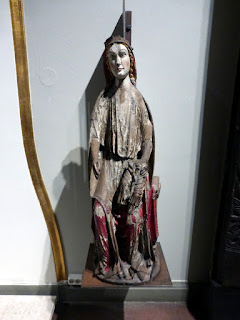The world's best preserved Viking helmet.
Norwegian coins which have a really interesting history.
This portal holds 15,000 Norwegian gold coins from 1874-1910. The coins are part of the central bank of Norway's gold that was loaded on board 26 trucks on the dramatic morning of 9 April 1940 when the Nazis invaded Norway. Under the cover name "The Heavy Luggage" Norway's gold reserves were transported out of Oslo and Norway while under constant danger from German troops and bombers. The gold was divided into portions, with most of it going overseas, to Britain, the US and Canada. Two British ships, HMS Galatea and HMS Glasgow plus Norwegian fishing vessels transported a total of 50 tonnes of gold out of the country, a large part in gold bars as well as coins. In 1987 the gold coins were returned to Norway.
The Viking Ship Museum houses the world's best preserved Viking ships found in burial mounds around the Oslo fjord. They crossed the seas before becoming the final resting places of their wealthy owners.
The Osberg ship was built around the year 820 and the bits of the ship found in the burial grounds were reconstructed so that about 85% of the original wood has been retained. The discovery of this ship is one of the most important archaeological finds in Norway and comprises the world's most extensive collection of wooden objects from the Viking age. Advances in preservation methods for wooden objects has assisted in stopping further degradation.
One of the elaborately carved sledges found buried with the ship.
We took a bus towards the Norwegian Maritime Museum further down the peninsula where the Viking Ship Museum is but we did not go in. These figures we think are part of the commemoration of the Amundsen South Polar expedition.
An unexploded mine which Charlie closely examined.
Whale harpoon guns. Norway still engages in whaling.
Skillebekk from across the harbour. The apartment block we are living in is left of the greenery.
After all this sightseeing it was time to try Oslo's best cinnamon rolls and coffee at WB Samson which is a chain of cafes. We are promised that there is one at Oslo Airport, but sadly not at Bergen, where we will be going later in September.
Norsk kanelboller - cinnamon rolls. These are truly delicious. Only in New Zealand, of all places, have I tasted anything remotely as good as these cinnamon rolls.
How the Norwegians stay so slim is beyond me with all these cafes and kanelboller! I think we have seen only one overweight person, a female. They are tall, slim sporty looking.
Maybe their secret is what is called friluftsliv (pronunced "fre-loofts-liv) or "free air life", which sounds like Nordic yoghurt but is, in fact, a complicated Scandinavian word for a simple and rather lovely concept. It is an abiding passion for landscape, and an active appreciation of the country's incredible natural beauty. This deep sense of calm spirituality - with a focus on balanced happiness and a common inclusive ethos - goes some way toward explaining how Norwegians have used their oil riches since the 1960s. They have worked out that a happy society is a fair society, where the nation's bounty is shared equally. Modern Norway's determined economic focus on the common good, combined with the deep belief in friluftsliv, emphasising active health and spiritual happiness has worked. It may be an alternative to the Danish concept of hygge ?
Time for photos of more beautiful buildings around the city. This district has many embassies and is a fairly high class neighbourhood. Buildings are not only beautifully preserved and clean but they are intrinsically appealing to the eye by their original design and architectural style.
The wonderful bay window. One can easily imagine living in an apartment such as that.

















No comments:
Post a Comment